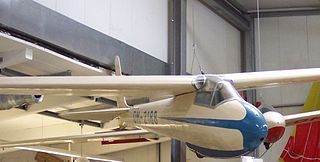Hans Jacobs was a German sailplane designer and pioneer. He had been taught sailplane design by Alexander Lippisch, designer of many gliders during the 1920s and the 1930s. As the head of the Deutsche Forschungsanstalt für Segelflug at Darmstadt in the years before World War II, he was responsible for a number of highly successful designs, including the DFS Rhönsperber, DFS Rhönadler, DFS Habicht, DFS Weihe, DFS Kranich, and the DFS 230 assault glider. Hans also designed a glider-seaplane, the "Sea Eagle", test flown by Hanna Reitsch. In 1936, Hans developed self-operating dive brakes, on the upper and lower surface of each wing, for gliders. He designed the DFS 230 used in the Battle of Fort Eben-Emael.

The Deutsche Forschungsanstalt für Segelflug, or DFS, was formed in 1933 to centralise all gliding activity in Germany, under the directorship of Professor Walter Georgii. It was formed by the nationalisation of the Rhön-Rossitten Gesellschaft (RRG) at Darmstadt.

The DFS Olympia Meise was a German sailplane designed by the Deutsche Forschungsanstalt für Segelflug (DFS) for Olympic competition, based on the DFS Meise.

The Slingsby Hengist was a British military glider designed and built by Slingsby Sailplanes Ltd. Like other British troop carrying gliders in the Second World War, it was named after military figures whose name began with H, in this case the Jute invader Hengist.

The Slingsby T.38 Grasshopper is a British primary training glider built by Slingsby Sailplanes for the Royal Air Force.

The Aer-Pegaso M-100 was a single-seat glider designed and built in Italy from 1957.

The Elliotts of Newbury EoN or Elliotts EoN A.P.4 was a 1940s British four-seat touring monoplane aircraft built by Elliotts of Newbury.

The Schneider Grunau Baby was a single-seat sailplane first built in Germany in 1931, with some 6,000 examples constructed in some 20 countries. It was relatively easy to build from plans, it flew well, and the aircraft was strong enough to handle mild aerobatics and the occasional hard landing. When the Baby first appeared, it was accepted wisdom that the pilot should feel as much unimpeded airflow as possible, to better sense rising and falling currents of air and temperature changes etc.

The Elliots Primary EoN or EoN Type 7 S.G.38 Primary was a training glider built in the UK shortly after World War II. It was an absolutely minimalist aircraft, consisting of a high, cable-braced wing connected to a conventional empennage by an open-truss framework, and was a copy of the German SG 38 Schulgleiter. Marketed to aeroclubs, the Primary EoN was also adopted in 1948 by the Air Training Corps and by the Combined Cadet Force under the name Eton TX.1. An example is at the Gliding Heritage Centre.
Frederick 'Fred' Nicholas Slingsby MM was the founder of Slingsby Sailplanes Ltd.

The Slingsby T.21 is an open-cockpit, side-by-side two-seat glider, built by Slingsby Sailplanes Ltd and first flown in 1944. It was widely used by the Royal Air Force, Sri Lanka Air Force and by civilian gliding clubs.
Chilton Aircraft Ltd was a British aircraft design and manufacturing company of the late 1930s and 1940s.

The Slingsby T.12 Gull was a British single-seat glider designed and built by Slingsby Sailplanes and first flown in 1938.
The Slingsby T.25 Gull 4 is a British glider designed and built by Slingsby that first flew in 1947.

The Eon Olympia was a glider produced from 1947 by Elliotts of Newbury.

In 1947 a British Gliding Association design competition, for a two-seat sailplane, was won by Hugh Kendall, Miles' assistant test pilot. It was a side-by-side two seater called the Kendall Crabpot I, with a 60 ft. span and an aspect ratio of 18. A version with a novel asbestos fibre-polymer wing and a wooden fuselage with a butterfly tail was proposed by Miles, but the wing failed under low loads. Elliotts of Newbury built a conventional wooden wing to use with Miles' fuselage. The resulting glider flew, but not well and development was abandoned with just one example built.

The Slingsby T.30 Prefect is a 1948 British modernisation of the 1932 single-seat Grunau Baby glider. About 53 were built for civil and military training purposes.

The EoN 460 series are wooden single-seat standard class sailplanes, built in the UK in the 1960s. It did not have major competition success but some remain in use in 2021.

The Schneider DFS 108-14 SG-38 Schulgleiter is a German high-wing, cable-braced, single-seat primary glider that was designed by Schneider, Rehberg and Hofmann at Edmund Schneider's factory at Grunau in 1938, hence the designation. It was produced by several builders, including Deutsche Forschungsanstalt für Segelflug (DFS).















